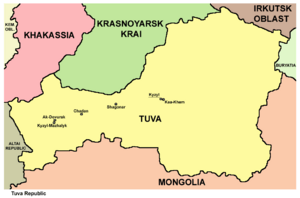Tuva facts for kids
Quick facts for kids Tuva RepublicРеспублика Тыва (Russian) Тыва Республика (Tuvan) |
|||||
|---|---|---|---|---|---|
| — Republic — | |||||
|
|||||
|
|||||
| Political status | |||||
| Country | Russia | ||||
| Federal district | Siberian Federal District | ||||
| Economic region | East Siberian Economic Region | ||||
| Established | March 31, 1992 | ||||
| Capital | Kyzyl | ||||
| Government (as of August 2010) | |||||
| • Chairman | Sholban Kara-ool | ||||
| • Legislature | Great Khural of Tuva | ||||
| Statistics | |||||
| Area (as of the 2002 Census) | |||||
| • Total | 170,500 km2 (65,800 sq mi) | ||||
| Area rank | 21st | ||||
| Population (2010 Census) | |||||
| • Total | 307,930 | ||||
| • Rank | 77th | ||||
| • Density | 1.81/km2 (4.7/sq mi) | ||||
| Time zone(s) | KRAT (UTC+08:00) | ||||
| ISO 3166-2 | RU-TY | ||||
| License plates | 17 | ||||
| Official languages | Russian; Tuvan | ||||
| Official website: http://gov.tuva.ru/ | |||||
The Tuva Republic (also called Tyva) is a special part of Russia. It is one of 85 areas that make up the country. Tuva is located in southern Siberia, a huge region in northern Asia.
Tuva is part of the Siberian Federal District, which includes nine other areas. It also shares a border with the country of Mongolia. This means Tuva is right next to another country!
Contents
Tuva's Past: A Brief History
How Tuva Became Part of Russia
Long ago, during the time of the Chinese Qing Dynasty, Tuva was part of Mongolia. This was a very old empire.
Later, from 1921 to 1944, Tuva was its own country. It was called Tannu-Tuva.
In 1944, Tannu-Tuva joined the Soviet Union. The Soviet Union was a very large country that included Russia. When the Soviet Union broke apart in 1991, Tuva remained a part of Russia.
Exploring Tuva: Geography and Climate
Where is Tuva Located?
Tuva is in a large valley. This valley sits between two mountain ranges. These are the Sayan Mountains and the Tannu-Ola Mountains.
The eastern part of Tuva has many forests. But the western part of the land is much drier.
Kyzyl: The Capital City
Kyzyl is the capital city of Tuva. The name "Kyzyl" means red in the Tuvan language.
Many Tuvans believe that Kyzyl is the exact center of Asia. There is even a monument in the capital city that marks this spot. However, some people disagree about the exact center.
Even so, Tuva is definitely in Central Asia. Because of this, Tuvan culture is very similar to the cultures of its neighbors in other Central Asian countries.
Tuva's Weather: Hot and Cold
Tuva has very cold winters. The average temperature in January is about -32 °C (-25.6 °F).
Summers are much warmer. The average temperature in July is around +18 °C (64.4 °F).
People of Tuva: Demographics and Culture
Who Lives in Tuva?
The number of people living in Tuva has been growing recently. A little more than half of the people live in cities and towns. Most of these city dwellers live in Kyzyl.
Most of the people in Tuva are ethnic Tuvans. Many ethnic Tuvans follow a religion that mixes Tibetan Buddhism with Shamanism. Shamanism is a belief system that respects spirits and nature.
Languages Spoken in Tuva
Tuvans speak their own language, called Tuvan. It is a Turkic language, which means it is related to languages like Turkish.
Before Tuva joined the Soviet Union, the Tuvan language used the Latin alphabet. This is the same alphabet that English uses. After joining the Soviet Union, Tuvans started using the Cyrillic alphabet. This is the same alphabet used for Russian. Since Tuva is part of Russia, Tuvans also learn to speak Russian.
Tuvan Culture: Horses, Yurts, and Singing
In the past, Tuvans were nomadic people. This means they traveled a lot and did not stay in one place. They rode horses everywhere. Because of this, horses were very important in Tuvan culture. Many Tuvan songs and artworks are about horses.
Tuvans used to live in yurts. These are round houses covered with felt. Yurts are easy to take apart and move. Even today, a few Tuvans still live as nomads.
Amazing Tuvan Throat Singing
Tuvans are famous for their special throat singing. This is a very old art form. It is amazing because a throat singer can sing two or more notes at the same time!
Throat singers often copy the sounds of nature. They can sound like birds or the howling wind. One style of throat singing even sounds like a horse trotting. For many centuries, only men were allowed to be throat singers. But now, women are also becoming throat singers. Singing more than one note at the same time is sometimes called overtone singing.
Unique Postage Stamps
Tannu-Tuva was also known for its colorful and unusual postage stamps. Some of these stamps were shaped like triangles! Many of them showed interesting pictures of daily life in Tuva.
Images for kids
-
Russian President Vladimir Putin in Tuva in 2007
-
A coal mine in Tuva
-
Russian Defense Minister Sergey Shoygu in 2012.
See also
 In Spanish: Tuvá para niños
In Spanish: Tuvá para niños




















